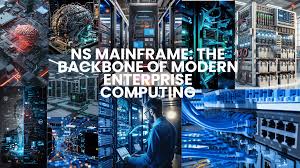When people hear the word mainframe, many instantly think of old, clunky machines from decades past. But here’s the surprising truth, mainframes are far from obsolete. In fact, they’re the backbone of some of the world’s most critical industries. From financial transactions and healthcare records to government services and enterprise IT infrastructure, mainframes quietly power the systems we rely on every single day.
The NS Mainframe is a perfect example. It’s not just about legacy technology; it’s about reliability, security, and scalability at a level most modern systems still struggle to achieve. Understanding what NS Mainframe is, how it works, and why it still matters can shed light on why enterprises continue to trust this technology in a fast-paced digital era. In this guide, we’ll walk through NS Mainframe basics, its business impact, technical strengths, and what makes it as relevant today as ever.
What is NS Mainframe?
At its core, the NS Mainframe is a large-scale computing system designed to handle massive amounts of data and transactions with unparalleled efficiency. Think of it as the central nervous system of enterprise IT—managing workloads, securing information, and keeping mission-critical applications running around the clock.
If you’re new to the topic, you might wonder about the difference between NS Mainframe meaning and NS Mainframe definition. The meaning is broader—it represents trust, stability, and continuity in enterprise systems. The definition is more technical: a high-performance computing platform that processes and stores data reliably, even under extreme demand.
For those diving deeper, an NS Mainframe guide or NS Mainframe tutorial can help break down the architecture, commands, and programming languages it uses. But for now, it’s enough to know that mainframes are built differently than ordinary servers—they’re engineered for volume, security, and resilience.
The Backbone of Mainframe Systems
Mainframe Computing in Action
Mainframe systems have been around for decades, but their computing power is still unmatched in certain fields. Unlike traditional servers, enterprise mainframes are designed to handle thousands of concurrent users and millions of transactions per second.
This strength makes them ideal for industries where accuracy and speed are non-negotiable. Whether it’s processing ATM withdrawals in banking or managing health insurance claims, transaction processing and batch processing are the bread and butter of mainframe computing. It’s not flashy, but it’s dependable—exactly what mission-critical industries need.
Mainframe Architecture and Operating Systems
One of the reasons mainframes remain so dominant is their architecture. A well-built mainframe architecture can run workloads that would otherwise bring down ordinary servers. These systems are supported by specialized mainframe operating systems like z/OS, which provide unmatched stability and security.
Mainframes also shine when it comes to managing vast amounts of structured data. A mainframe database can handle sensitive financial records, healthcare data, or government archives without compromising speed or reliability. Coupled with features like high availability systems, downtime is almost nonexistent.
Data Centers and Reliability
Modern enterprises run on data center infrastructure, and this is where mainframes prove their worth. When downtime can cost millions—or even lives—mainframe reliability becomes the gold standard. These machines are built for resilience, with redundancy, failover mechanisms, and security at their core.
This reliability is why Fortune 500 companies and public institutions still use mainframes as the backbone of their IT operations. While cloud and distributed computing are rising fast, mainframes continue to hold their ground where nothing less than perfect uptime is acceptable.
Business & Enterprise Use Cases
Financial and Banking Sector
Banks are some of the heaviest users of mainframes, and for good reason. Mainframe in banking enables the processing of credit card payments, ATM transactions, and online transfers instantly and securely. The mainframe in finance sector also benefits from the system’s ability to handle regulatory compliance, fraud detection, and high-volume workloads without hiccups.
Every time you swipe a card or check your account balance, there’s a good chance a mainframe is working behind the scenes to make it happen. This invisible reliability is why financial institutions continue to trust NS Mainframe systems in an age where customer expectations are higher than ever.
Government and Public Sector
Governments also rely heavily on mainframes for record-keeping, security, and large-scale data processing. From social services and taxation to defense systems, mainframe in government ensures stability and continuity. Public agencies can’t afford system downtime, and mainframes deliver the consistency required to keep vital services running.
Healthcare and Beyond
In healthcare, patient data security and compliance with regulations like HIPAA are non-negotiable. This is where mainframe in healthcare makes a huge difference. Hospitals and insurers use mainframes for storing electronic health records, managing claims, and running secure applications.
Beyond healthcare, industries like retail, transportation, and logistics also rely on mission-critical applications that mainframes handle with ease. Whether it’s ensuring supply chains stay intact or keeping airlines on schedule, mainframes help businesses maintain business continuity with mainframes even during disruptions.Mainframes and Future Tech
Mainframes aren’t just surviving—they’re evolving. Emerging technologies like artificial intelligence and machine learning are finding their way into mainframe environments. With AI and mainframes, organizations can analyze massive datasets faster, automate repetitive tasks, and strengthen predictive analytics for decision-making.
Security is another area where mainframes shine. Cybersecurity in mainframes isn’t just about keeping hackers out—it’s about ensuring the integrity of millions of daily transactions. Features like encrypted data storage, access controls, and monitoring tools make mainframes one of the most secure computing platforms available.
And with ongoing mainframe performance optimization, enterprises can ensure these systems remain fast, scalable, and ready for modern demands. Far from being a relic, the NS Mainframe is adapting to meet tomorrow’s challenges head-on.
Why NS Mainframe Still Matters in the Modern Era
Mainframe Modernization
One common misconception is that mainframes are outdated. In reality, many organizations are actively investing in mainframe modernization. This means upgrading hardware, adopting cloud-native interfaces, and integrating modern programming practices while keeping the core system intact.
For companies, this is a cost-effective way to leverage the legacy mainframe systems they already have while ensuring they’re not left behind in today’s digital-first landscape.
Competing and Collaborating with the Cloud
We often hear debates about mainframe vs cloud computing. The truth? It’s not really a competition. In most cases, enterprises adopt a hybrid IT infrastructure, where mainframes handle secure, mission-critical workloads and the cloud powers flexible, customer-facing applications.
This cloud and mainframe integration approach delivers the best of both worlds: stability and scalability combined with innovation and agility.
Vendors, Platforms & Tools That Power NS Mainframe
When people think about mainframes, one name often comes up: IBM. The IBM mainframe family, especially the z-series, continues to dominate the enterprise landscape. These systems are built for performance, scalability, and integration with modern IT.
Alongside the hardware, a suite of powerful tools keeps mainframes relevant. Languages like COBOL on mainframes still run a huge portion of enterprise applications, while JCL (Job Control Language) is used to manage complex workloads. Middleware such as CICS (Customer Information Control System) allows transaction-heavy applications to run seamlessly, while DB2 on mainframe provides robust data management.
Other critical tools include IMS (Information Management System) for hierarchical databases and RACF (Resource Access Control Facility) for enterprise-grade security. Together, these platforms form a powerful ecosystem that supports industries where reliability is not optional.Learning Curve and Skills for Mainframe Professionals
History and Evolution of Mainframes
To really understand why NS Mainframe still matters, it helps to know where it came from. The history of mainframes stretches back to the 1950s, when massive computers filled entire rooms and processed data with punch cards. Over the decades, the evolution of mainframe computers has been remarkable—moving from room-sized machines to compact, ultra-efficient systems that can handle workloads modern servers still struggle with.
Comparisons like mainframe vs server or mainframe vs supercomputer are common. While servers are more flexible and supercomputers excel in scientific calculations, mainframes sit in the middle—offering unmatched reliability, speed, and transaction-handling capabilities.
Skills and Training
Mainframes may feel intimidating at first, but the skillset needed is surprisingly straightforward once you get familiar. Developers working with mainframes often need to know mainframe programming languages like COBOL, Assembler, or even newer integrations with Java and Python.
Critical mainframe developer skills include understanding job control, data management, and transaction systems. While it may sound niche, the demand for skilled professionals is still strong.
Fortunately, there are plenty of resources for those interested in learning mainframes. From online mainframe training resources to in-house corporate programs, opportunities exist for new IT professionals to step into this specialized but valuable field. And with many experienced mainframe engineers nearing retirement, the demand for fresh talent is only going up.NS Mainframe in Enterprise Transformation
Digital transformation is a buzzword across industries, and mainframes are very much part of that conversation. While they are often labeled as legacy mainframe systems, the reality is that enterprises are finding new ways to integrate them into modern strategies.
For many organizations, the NS Mainframe is the anchor of enterprise IT infrastructure. It provides the secure, reliable foundation needed to explore innovations like mobile apps, cloud-native platforms, and artificial intelligence without risking core operations. This is the essence of mainframe digital transformation: merging the old with the new in a way that drives value.
Think about industries like logistics, where tracking shipments in real time is crucial. Or healthcare, where secure records must be instantly accessible yet completely private. These are cases where mainframes shine—ensuring continuity while enabling progress.
By combining scalability and mainframes with cloud flexibility, enterprises gain the best of both worlds. They can modernize their front-end experiences while ensuring their back-end remains solid and dependable. That’s why, despite endless predictions about their decline, mainframes continue to power critical sectors.
Key Takeaways from NS Mainframe’s Journey
The story of the NS Mainframe is one of resilience and reinvention. From its roots in early mainframe systems to its role in today’s hybrid IT environments, it has remained a constant presence in industries where failure is not an option.
It continues to serve as the backbone for mission-critical applications across finance, government, and healthcare. With ongoing mainframe modernization, seamless cloud and mainframe integration, and advances in cybersecurity and AI, NS Mainframe is not just relevant—it’s essential.
Far from being a relic of the past, it represents the very future of reliable, secure, and scalable computing.




